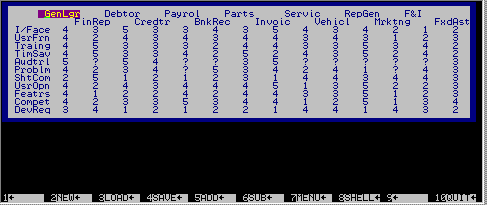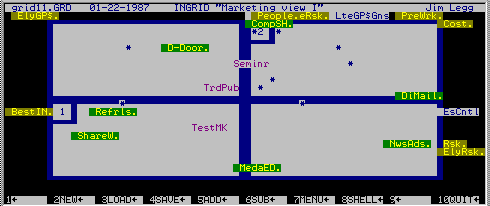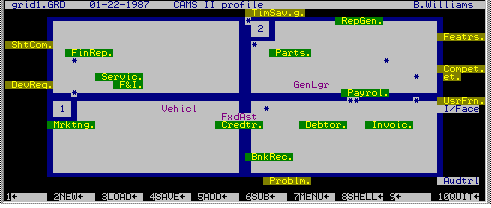
Thirdly, you can re-analyse the grid after each "what if" re-evaluation and see whether the outcome is satisfactory. Piece by piece you can restructure a situation in a controlled manner.
An example of where I personally used Ingrid in a planning role is as follows:
As a new Software Development Manager for a large computer company specialising in Vertical Market Packages, I had to assess the short term requirements for a computer program for automotive distributors. This program was undergoing a major rewrite and a tense situation existed with the user group.
In order to get a "Profile" of the situation I broke the computer program into 14 separately identifiable "Modules" and then formulated a question.
"To what extent do these modules satisfy our customer's needs?"
With this question in mind and using a five point scale, I interviewed the product manager responsible for the program and got the following grid from him. The constructs came directly from examining what was good or bad about the modules in respect of the above question.
The following is the actual grid1.txt data as fed into Ingrid and the meanings of the attributes:-

This produced the following picture:-

Armed with a profile which clearly identified the problem areas and the reasons why as being in the lower left quadrant of the screen and the good aspects in the upper right quadrant of the screen. I set about "releasing" each problem module in turn and taking new *pictures*. In doing so I was writing a report on the steps to be taken.
*Releasing* each problem module involved making an assumption about what would happen in the near future and then re-evaluating the constructs just for that element.
*Taking pictures* was done after each *release* to gauge the result of the *remedy*. If the result was encouraging (i.e. the element moved toward the good side of the screen) then I would write notes into my report and thus one by one each and every solvable problem area was accounted for. During the session, which should be noted took just under an hour, we were only able to address short term solutions for the four modules listed below and the "Marketing" & "F&I" (Finance & Insurance) were referred to a user group committee for further specification.
| grid1-4.txt | Financial Reports | Creditor | Bank Reconcile | Service |
| Time Saving | 2 > 3 | |||
| Problems | 4 > 3 | 5 > 2 | ||
| Short Comings | 5 > 3 | 4 > 2 | ||
| User's Opinions | 2 > 4 | 3 > 4 | 4 > 1 | 1 > 4 |
| Selling Features | 1 > 4 | 2 > 3 | 2 > 4 | |
| Competitiveness | 2 > 4 | 1 > 3 | ||
| Development Reqd | 4 > 3 | 2 > 1 | 4 > 2 |

It is interesting to note that two factors crossed the "significance" threshold, namely "Problm" and "I/face". The significance threshold is high if a "." is printed after the name. Although "Credtr" and "BnkRec" did not make radical moves on the screen they became insignificant to the major concerns still confronting the whole computer package.
Incidentally I proved my "profile" by getting the same grid filled in
by two software support consultants. Their Consensus
analysis showed the same substance as the one above.
Contact j.Maxwell LEGG
mailto: income@ihug.co.nz